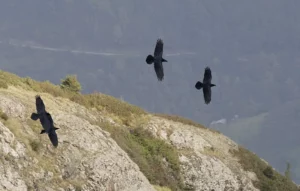Ravens are larger-bodied birds belonging to the genus Corvus. There are two types of them found as per their habitat. Let us study their significant features.
Ravens move with a combination of walking and hopping. Their movement is often described as two-footed Hops. Common ravens are found to be moving around by walking on the ground besides flying. Majorly small birds tend to hop rather than bigger birds, that’s why the movement of the raven is a combination of both.
Ravens generally move in pairs. They are much larger in size than the common crows. The movement of ravens cannot be predetermined and they have several significant characteristics along with walking and hopping.
Why Do Ravens Hop
Ravens are considered very intelligent birds among all other members of the avian family. They show some intriguing movements in daily life. Let us find out the reason behind it.
Ravens choose to hop greater distances and sometimes walk over short distances to conserve their energy. The choice of walking or hopping depends upon the intention behind it, like the distance of food, breeding ground, and many more.

Mike Pennington is licensed under CC BY-SA 2.0
Do Ravens Flap Or Glide
The flapping term is referred to the flying preparation of a bird by moving up and down. Birds do glide when they do not flap to fly with less resistance. Let us know more.
Common ravens are more likely to glide and soar while making intermittent, shallow flaps. Ravens occasionally even flip over or somersault while flying. When they fly, they typically cease flapping and soar instead.
Ravens can perform aerobatic tricks like looping, diving, rolling, and collecting twigs in flight in addition to soaring. Their wings make certain sounds while flying. The common raven can fly upside-down.
How Do Ravens Flap Or Glide
The raven’s wings give them lift and stability as they fly. They have extremely strong bones and feathers with incredible lightweight. Let us learn more about their attributes.
Ravens can flap their wings up to 80 times per second, which is much faster than the majority of other birds. They have the ability to fly in the wind’s direction. By dropping their wings and using the wind to slow down, they can also glide for brief distances.
They typically only make brief, infrequent flaps while they glide. The flight muscle of the Raven is called Pectoralis Major, which can extend and contract in a certain time period. Their wings take an oval shape and are proven to be better than other flying birds.

How Ravens Differ From Crows In Movement
Although crows and ravens have similar appearances, there are several ways to tell them apart. We will focus on the main variations in their locomotory organs and flying movements.
| Characteristics | Ravens | Crows |
|---|---|---|
| 1. Sound of wings | Their wings make a swishing sound while flying. | Their wings do not make any sound in flight. |
| 2. Flying Attributes | They occasionally somersault but tend to glide and soar more with infrequent flaps while flying. | They are more energetic with frequent flaps in flight. |
| 3. Behavior | They are solitary birds, found in pairs sometimes. | They mainly fly in flocks. |
| 4. Tail | Their tail is diamond or V-shaped. | Their tail is fan-like. |
| 5. Size of wings | Wings are longer with crooked ends and long finger spaces. | Their wings are straight with very little bending at the edge. |
In addition, there are numerous other differences between crows and ravens, such as differences in their feathers, beaks, necks, weight, lifespan, calls, habitats, diets, and more.

Conclusion
Ravens are bigger and better flyers in their domain and are considered an intelligent species. They can display several movements such as gliding, soaring, and flapping during their flight. They can conserve energy by walking and this makes them smarter than the other species in the same Corvidae family.

